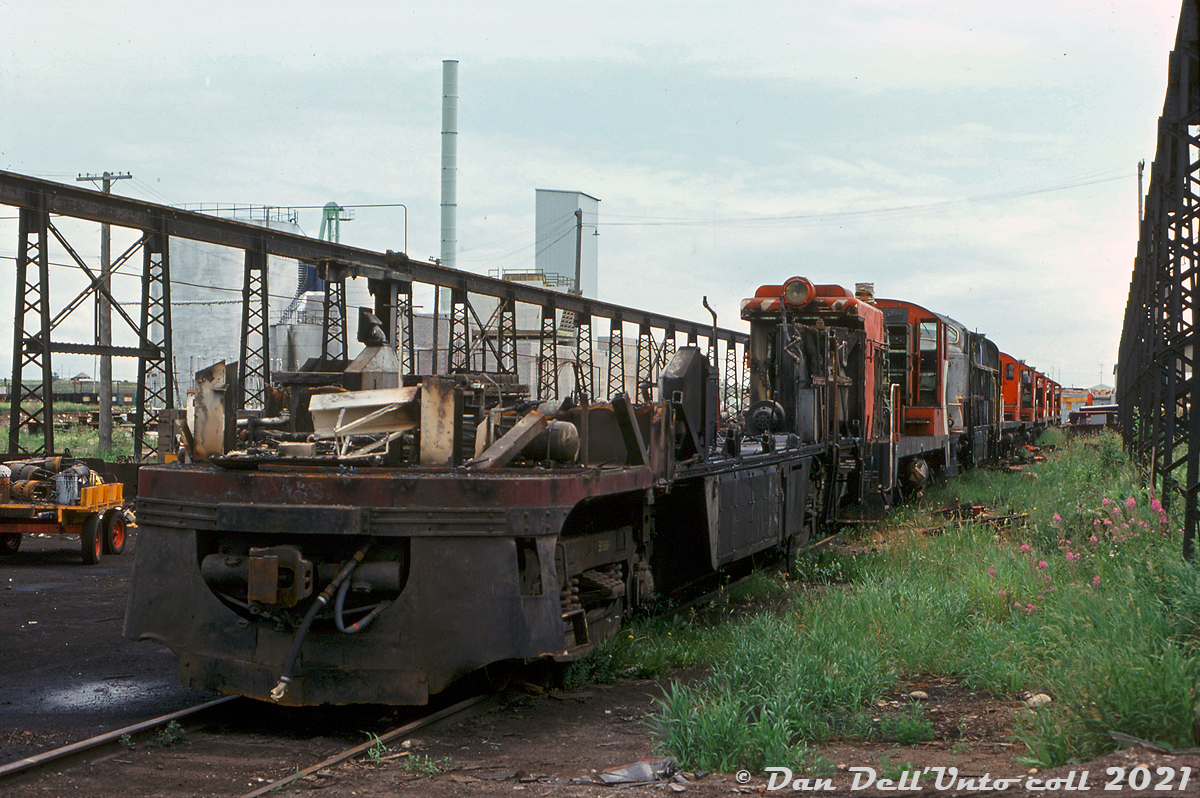|
Caption: The sad end of CP's Canadian Locomotive Company (Fairbanks Morse) and Baldwin locomotive fleets: the cut-down remains of a CLC C-Liner sits at the end of the scrapping line at Ogden Shops, ahead of a string of Baldwin DS4-4-1000 and DRS4-4-1000 locomotives and another C-Liner, all in the process of being stripped down and eventually cut up. Just a few sandboxes, air tanks, and other components remain above the frame of the lead unit, after the carbody was stripped off and internal components salvaged.
Going by some spotting features, the lead unit appears to have been CP CFA16-4 4057, likely followed by DS4-4-1000 7073, and CPA16-4 4105. The fifth unit is another switcher, 7068, and the other four mixed in are DRS4-4-1000 units 8001-8004 in unknown order (except the final unit, 8004). All were retired in 1975 during the great purge of CLC, MLW and Baldwin power due to a system-wide downturn in traffic.
For those inclined, here's a short history of the two oddball fleets:
The FM/CLC units:
Fairbanks Morse (designs licensed to Canadian Locomotive Company in Kingston for Canadian production) made a name for themselves during dieselization by offering their opposed-piston diesel engines (popular for marine use) in their diesel locomotives, producing more power than the competition with fewer cylinders. They offered a wide range of configurations in their streamlined Consolidation line ("C-Liner"), 4- and 6-axle road switchers (H-series, including the most powerful on the market: their 2400hp "Train Master"), and small switching units. Alas, increased competition, reliability issues and decreased orders saw FM exit the locomotive market in the late 50's. Most railroads gradually repowered or retired their FM/CLC locomotives in the 60's, by that time many considered them oddballs, non-standard or unreliable (at least for railroad use).
CP kept their fleet going much longer than other roads, mainly in the west based out of Nelson BC and Alyth (Calgary AB). However as the 70's rolled around and newer 6-axle mainline power was purchased, plans were in place to gradually retire the CLC fleet: as units failed or faced extensive repairs they were retired, and as part of the phase-out, regular overhauls were reduced or cancelled. A traffic downtown in the mid-1970's accelerated much of this: CP took a bunch of leasers off-lease, parked much of their MLW 244-powered fleet, and retired most of their CLC and Baldwin units.
The end:
In March 1975, the power desk issued an order to round up all the remaining CLC power, dead or alive, and send it to Ogden for storage (CP's parlance was tied up unserviceable/serviceable). A handful of F-units and GP9's were reassigned to Nelson as replacements (but only lasted a few months before Nelson shop itself was closed in June 1975). This included the fleet of H16-44 roadswitchers, and what few C-Liners remained. The CP C-Liners were the last of their kind operating anywhere in North America, and by 1975 only five units remained in service: 4053, 4057, 4065, 4104 and 4105 (4057 officially retired in March because of a frozen engine block, the rest in June).
There was talk of the monthly cost of maintaining the CLC fleet versus leasers, and plans to keep some of the units stored for possible traffic increases, but ultimately the remaining fleet ended up officially retired June 20th 1975 and subsequently scrapped. Parts off the CLC fleet common to other power (notably MLWs) that CP wanted to reuse were the GE 752 traction motors, air compressors, SKF roller bearings, wheels and axle sets. CP ended up selling roughly two-dozen of the retired unit's engine blocks to an equipment supply company out of Houston TX (as the opposed-piston engines were popular in the secondhand market for marine use). Only three units were spared for preservation: 4065, 4104 and 8554. CP's three remaining Train Masters survived in hump service until they were similarly phased out.
The Baldwins:
The Baldwin fleet was made up of a small handful of DRS4-4-1000 roadswitchers (8000-8012) and DS4-4-1000 switchers (7065-7075), ordered by CP early on to fully dieselize their E&N Vancouver Island operations and the surrounding port area in the late 1940's. Because both Alco/MLW and EMD couldn't guarantee production space for CP's order, CLC brokered a deal for Baldwin to produce the 1000 horsepower units, which were built at Eddystone PA.
Their isolation out west no doubt contributed to their longevity, but by the 1970's they were oddballs and similarly phased out by CP. Four 8000's were wrecked in 1973, and most of the others still active were retired in 1975. Units 8000-8004 (plus 7068 and 7073) were officially retired June 5th 1975, and 8009-8010 in December of that year, but some of the switchers lasted a bit longer (the final unit retired in 1982). 8000 was spared for preservation, but 8001-8004 and the two switchers were cut up here at Ogden.
Original photographer unknown, Dan Dell'Unto collection slide.
|



Didn’t some of the units sit at Ogden for decades rusting away?
I think some units did for a few years, but mostly in years past as wrecks and parts units. Once the whole fleet was retired, it probably made little sense to keep any around. A small group were kept for CP’s historic fleet, and eventually dispersed.